Round Continuously Variable Metallic Neutral Density Filters
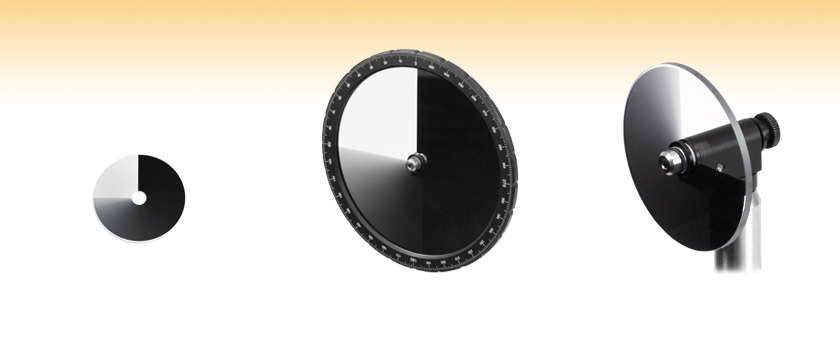
- Linear, Adjustable Attenuation by Rotation
- Optical Density Range: 0.04 - 2.0, 0.04 - 4.0
- UV Fused Silica Substrate
- Uncoated and AR-Coated Versions
NDC-50C-2
Ø50 mm ND Filter
OD: 0.04 - 2.0
NDC-100C-4M
Mounted Ø100 mm ND Filter
OD: 0.04 - 4.0
NDC-50C-2 Variable ND Filter
Mounted on Ø1/2" Post
Using an NDC-PM Mount
Application Idea

Please Wait
| Variable ND Selection Guide | ||||||
|---|---|---|---|---|---|---|
| Image |  |
 |
 |
 |
 |
 |
| ND Filter Type |
Round Step | Round Continuous |
Cage Compatible |
Rectangular Step |
Rectangular Continuous |
Variable Absorptive ND Filter |
Features
- Circular, Continuously Variable, Reflective Neutral Density Filter
- Optical Density Range: 0.04 - 2.0 or 0.04 - 4.0
- Ø25 mm, Ø50 mm, and Ø100 mm Sizes
- Three Back-Side Coating Options:
- Uncoated (240 - 1200 nm)
- AR Coated for the 350 - 700 nm Range
- AR Coated for the 650 - 1050 nm Range
- Mounted and Unmounted Versions
These circular, continuously variable reflective neutral density filters provide attenuation that can be adjusted linearly within the coated region via rotation. They are composed of a UV fused silica glass substrate and a metallic Inconel coating through a full 270°, ensuring a flat spectral response from the ultraviolet to the mid-infrared. These filters have optical densities ranging from either 0.04 to 2.0 or 0.04 to 4.0. The optical density (OD, see Equation 1) increases linearly from the start of the coating. For more information, please refer to the Specs tab.
The mounted versions of our continuously variable neutral density filters come with angular graduations and are mounted on a rotating axle. The mount has been carefully designed to minimize the effect on the clear aperture of the optic. Each mounted filter includes adapters for both 8-32 and M4 mounting holes, making the mounted filter compatible with Thorlabs' Ø1/2" TR Series Posts and accessories.
Optical density (OD) indicates the attenuation factor provided by an optical filter, i.e. how much it reduces the optical power of an incident beam. OD is related to the transmission, T, by Equation 1

where T is a value between 0 and 1. Choosing an ND filter with a higher optical density will translate to lower transmission and greater reflection of the incident light. For higher transmission and less reflection, a lower optical density would be appropriate. As an example, if a filter with an OD of 2 results in a transmission value of 0.01, this means the filter attenuates the beam to 1% of the incident power. Please note that it is typical to see as much as a 50% drop in power going from the uncoated region to the coated region for filters with a max OD of 4.
Inconel is a metallic alloy that ensures flat spectral response from the UV to the near IR. Unprotected metal coatings like this should only be cleaned by blown air, never touched, as contact may cause scratching to the unprotected surface. Although these are reflective ND filters, the Inconel coating does absorb some of the incident light, which limits the use of these filters to low-power applications. Inconel is resistant to aging under normal conditions; however, it will oxidize at elevated temperatures. To prevent oxidation, Thorlabs recommends using these ND filters at temperatures below 100°C. To achieve the best performance light should be incident on the side with the Inconel coating.
These filters are not intended to serve as laser safety equipment. For lab safety, Thorlabs offers an extensive line of safety and blackout products that significantly reduces exposure to stray or reflected light.
| Common Specifications | |
|---|---|
| Substrate Material | UV Fused Silicaa |
| Diameter Tolerance (A & B) | Outer Diameter: +0.00/-0.25 mm Inner Diameter:+0.25/-0.00 mm |
| Thickness Tolerance |
±0.25 mm |
| Coating Radial Angle (E) | 270° ± 5° |
| Spectral Range | 240 - 1200 nm |
| Filter Thickness (F) | 2 mm |
| Front ND Coating | Inconel (NiCrFe) |
| Surface Flatness | <λ (per cm2) |
| Surface Quality | 60-40 Scratch-Dig |
| Parallelism | <3 arcmin |
| Optical Density Tolerance |
±5% (At Both Extremes) |
| Linearity of Density | ±5% |
| Ravg (AR-Coated Optics) | <0.5% From 350 - 700 nm for Item #s Ending -A From 650 - 1050 nm for Item #s Ending -B |
| Base Item #a | Optical Densityb |
Clear Aperture | Housing Diameter |
Housing Thickness |
Unmounted Optic Dimensions | |||||
|---|---|---|---|---|---|---|---|---|---|---|
| A | B | C | D | |||||||
| NDC-25C-2 | 0.04 - 2.0 | >9.5 mm ID and <22 mm OD | - | - | Ø25.0 mm | Ø7.5 mm | Ø8.0 mm | Ø23.0 mm | ||
| NDC-25C-4 | 0.04 - 4.0 | |||||||||
| NDC-50C-2 | 0.04 - 2.0 | >9.5 mm ID and <47 mm OD | - | - | Ø50.0 mm | Ø7.5 mm | Ø8.0 mm | Ø48.0 mm | ||
| NDC-50C-4 | 0.04 - 4.0 | |||||||||
| NDC-100C-2 | 0.04 - 2.0 | >9.5 mm ID and <97 mm OD | - | - | Ø100.0 mm | Ø7.5 mm | Ø8.0 mm | Ø98.0 mm | ||
| NDC-100C-4 | 0.04 - 4.0 | |||||||||
| NDC-25C-2M | 0.04 - 2.0 | >9.5 mm ID and <22 mm OD | 33 mm | 4 mm | Ø25.0 mm | Ø7.5 mm | Ø8.0 mm | Ø23.0 mm | ||
| NDC-25C-4M | 0.04 - 4.0 | |||||||||
| NDC-50C-2M | 0.04 - 2.0 | >9.5 mm ID and <45.5 mm OD | 63.5 mm | 5 mm | Ø50.0 mm | Ø7.5 mm | Ø8.0 mm | Ø48.0 mm | ||
| NDC-50C-4M | 0.04 - 4.0 | |||||||||
| NDC-100C-2M | 0.04 - 2.0 | >9.5 mm ID and <96 mm OD | 114.3 mm | 5 mm | Ø100.0 mm | Ø7.5 mm | Ø8.0 mm | Ø98.0 mm | ||
| NDC-100C-4M | 0.04 - 4.0 | |||||||||
Optical Density as a Function of Angle
The optical density is a linear function of the angle:
OD = mθ
where OD is the optical density and θ is the angle in degrees. The value of m depends upon the optical density range of the particular ND filter:
- For filters with a OD range of 0.04 - 2.0, m = 0.00741.
- For filters with a OD range of 0.04 - 4.0, m = 0.0148.
This formula assumes 0° at the point where the coating begins and 270º at the end of the coating (i.e., the point of highest optical density).
These curves illustrate the angular dependence of the AR coating that is on the back side of some of our ND filters. Please see the product groupings below for more information on the coated ND filters.
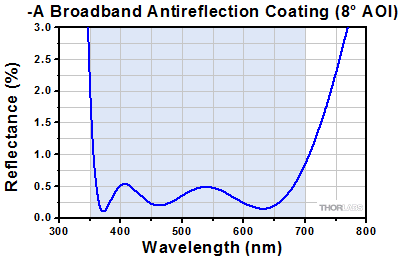
Click to Enlarge
Click Here for Raw Data
The blue shaded region indicates the specified 350 - 700 nm wavelength range for optimum performance.

Click to Enlarge
Click Here for Raw Data
The blue shaded region indicates the specified 650 - 1050 nm wavelength range for optimum performance.
| Table 4.1 Damage Threshold Specifications | |
|---|---|
| Optical Density | Damage Threshold |
| 0.3 | 0.025 J/cm2 (355 nm, 10 ns, 10 Hz, Ø0.772 mm) |
| 1.0 | 0.05 J/cm2 (355 nm, 10 ns, 10 Hz, Ø0.772 mm) |
| 2.0 | 0.075 J/cm2 (355 nm, 10 ns, 10 Hz, Ø0.772 mm) |
Damage Threshold Data for Thorlabs' Continuously Variable Metallic ND Filters
The specifications in Table 4.1 are measured damage thresholds for our non-variable ND filters. Our continuously variable metallic ND filters will exhibit similar performance at the discrete values listed. Damage threshold specifications are constant for a given optical density, regardless of the size of the filter.
Laser Induced Damage Threshold Tutorial
The following is a general overview of how laser induced damage thresholds are measured and how the values may be utilized in determining the appropriateness of an optic for a given application. When choosing optics, it is important to understand the Laser Induced Damage Threshold (LIDT) of the optics being used. The LIDT for an optic greatly depends on the type of laser you are using. Continuous wave (CW) lasers typically cause damage from thermal effects (absorption either in the coating or in the substrate). Pulsed lasers, on the other hand, often strip electrons from the lattice structure of an optic before causing thermal damage. Note that the guideline presented here assumes room temperature operation and optics in new condition (i.e., within scratch-dig spec, surface free of contamination, etc.). Because dust or other particles on the surface of an optic can cause damage at lower thresholds, we recommend keeping surfaces clean and free of debris. For more information on cleaning optics, please see our Optics Cleaning tutorial.
Testing Method
Thorlabs' LIDT testing is done in compliance with ISO/DIS 11254 and ISO 21254 specifications.
First, a low-power/energy beam is directed to the optic under test. The optic is exposed in 10 locations to this laser beam for 30 seconds (CW) or for a number of pulses (pulse repetition frequency specified). After exposure, the optic is examined by a microscope (~100X magnification) for any visible damage. The number of locations that are damaged at a particular power/energy level is recorded. Next, the power/energy is either increased or decreased and the optic is exposed at 10 new locations. This process is repeated until damage is observed. The damage threshold is then assigned to be the highest power/energy that the optic can withstand without causing damage. A histogram such as that below represents the testing of one BB1-E02 mirror.

The photograph above is a protected aluminum-coated mirror after LIDT testing. In this particular test, it handled 0.43 J/cm2 (1064 nm, 10 ns pulse, 10 Hz, Ø1.000 mm) before damage.

| Example Test Data | |||
|---|---|---|---|
| Fluence | # of Tested Locations | Locations with Damage | Locations Without Damage |
| 1.50 J/cm2 | 10 | 0 | 10 |
| 1.75 J/cm2 | 10 | 0 | 10 |
| 2.00 J/cm2 | 10 | 0 | 10 |
| 2.25 J/cm2 | 10 | 1 | 9 |
| 3.00 J/cm2 | 10 | 1 | 9 |
| 5.00 J/cm2 | 10 | 9 | 1 |
According to the test, the damage threshold of the mirror was 2.00 J/cm2 (532 nm, 10 ns pulse, 10 Hz, Ø0.803 mm). Please keep in mind that these tests are performed on clean optics, as dirt and contamination can significantly lower the damage threshold of a component. While the test results are only representative of one coating run, Thorlabs specifies damage threshold values that account for coating variances.
Continuous Wave and Long-Pulse Lasers
When an optic is damaged by a continuous wave (CW) laser, it is usually due to the melting of the surface as a result of absorbing the laser's energy or damage to the optical coating (antireflection) [1]. Pulsed lasers with pulse lengths longer than 1 µs can be treated as CW lasers for LIDT discussions.
When pulse lengths are between 1 ns and 1 µs, laser-induced damage can occur either because of absorption or a dielectric breakdown (therefore, a user must check both CW and pulsed LIDT). Absorption is either due to an intrinsic property of the optic or due to surface irregularities; thus LIDT values are only valid for optics meeting or exceeding the surface quality specifications given by a manufacturer. While many optics can handle high power CW lasers, cemented (e.g., achromatic doublets) or highly absorptive (e.g., ND filters) optics tend to have lower CW damage thresholds. These lower thresholds are due to absorption or scattering in the cement or metal coating.

LIDT in linear power density vs. pulse length and spot size. For long pulses to CW, linear power density becomes a constant with spot size. This graph was obtained from [1].

Pulsed lasers with high pulse repetition frequencies (PRF) may behave similarly to CW beams. Unfortunately, this is highly dependent on factors such as absorption and thermal diffusivity, so there is no reliable method for determining when a high PRF laser will damage an optic due to thermal effects. For beams with a high PRF both the average and peak powers must be compared to the equivalent CW power. Additionally, for highly transparent materials, there is little to no drop in the LIDT with increasing PRF.
In order to use the specified CW damage threshold of an optic, it is necessary to know the following:
- Wavelength of your laser
- Beam diameter of your beam (1/e2)
- Approximate intensity profile of your beam (e.g., Gaussian)
- Linear power density of your beam (total power divided by 1/e2 beam diameter)
Thorlabs expresses LIDT for CW lasers as a linear power density measured in W/cm. In this regime, the LIDT given as a linear power density can be applied to any beam diameter; one does not need to compute an adjusted LIDT to adjust for changes in spot size, as demonstrated by the graph to the right. Average linear power density can be calculated using the equation below.

The calculation above assumes a uniform beam intensity profile. You must now consider hotspots in the beam or other non-uniform intensity profiles and roughly calculate a maximum power density. For reference, a Gaussian beam typically has a maximum power density that is twice that of the uniform beam (see lower right).
Now compare the maximum power density to that which is specified as the LIDT for the optic. If the optic was tested at a wavelength other than your operating wavelength, the damage threshold must be scaled appropriately. A good rule of thumb is that the damage threshold has a linear relationship with wavelength such that as you move to shorter wavelengths, the damage threshold decreases (i.e., a LIDT of 10 W/cm at 1310 nm scales to 5 W/cm at 655 nm):

While this rule of thumb provides a general trend, it is not a quantitative analysis of LIDT vs wavelength. In CW applications, for instance, damage scales more strongly with absorption in the coating and substrate, which does not necessarily scale well with wavelength. While the above procedure provides a good rule of thumb for LIDT values, please contact Tech Support if your wavelength is different from the specified LIDT wavelength. If your power density is less than the adjusted LIDT of the optic, then the optic should work for your application.
Please note that we have a buffer built in between the specified damage thresholds online and the tests which we have done, which accommodates variation between batches. Upon request, we can provide individual test information and a testing certificate. The damage analysis will be carried out on a similar optic (customer's optic will not be damaged). Testing may result in additional costs or lead times. Contact Tech Support for more information.
Pulsed Lasers
As previously stated, pulsed lasers typically induce a different type of damage to the optic than CW lasers. Pulsed lasers often do not heat the optic enough to damage it; instead, pulsed lasers produce strong electric fields capable of inducing dielectric breakdown in the material. Unfortunately, it can be very difficult to compare the LIDT specification of an optic to your laser. There are multiple regimes in which a pulsed laser can damage an optic and this is based on the laser's pulse length. The highlighted columns in the table below outline the relevant pulse lengths for our specified LIDT values.
Pulses shorter than 10-9 s cannot be compared to our specified LIDT values with much reliability. In this ultra-short-pulse regime various mechanics, such as multiphoton-avalanche ionization, take over as the predominate damage mechanism [2]. In contrast, pulses between 10-7 s and 10-4 s may cause damage to an optic either because of dielectric breakdown or thermal effects. This means that both CW and pulsed damage thresholds must be compared to the laser beam to determine whether the optic is suitable for your application.
| Pulse Duration | t < 10-9 s | 10-9 < t < 10-7 s | 10-7 < t < 10-4 s | t > 10-4 s |
|---|---|---|---|---|
| Damage Mechanism | Avalanche Ionization | Dielectric Breakdown | Dielectric Breakdown or Thermal | Thermal |
| Relevant Damage Specification | No Comparison (See Above) | Pulsed | Pulsed and CW | CW |
When comparing an LIDT specified for a pulsed laser to your laser, it is essential to know the following:

LIDT in energy density vs. pulse length and spot size. For short pulses, energy density becomes a constant with spot size. This graph was obtained from [1].
- Wavelength of your laser
- Energy density of your beam (total energy divided by 1/e2 area)
- Pulse length of your laser
- Pulse repetition frequency (prf) of your laser
- Beam diameter of your laser (1/e2 )
- Approximate intensity profile of your beam (e.g., Gaussian)
The energy density of your beam should be calculated in terms of J/cm2. The graph to the right shows why expressing the LIDT as an energy density provides the best metric for short pulse sources. In this regime, the LIDT given as an energy density can be applied to any beam diameter; one does not need to compute an adjusted LIDT to adjust for changes in spot size. This calculation assumes a uniform beam intensity profile. You must now adjust this energy density to account for hotspots or other nonuniform intensity profiles and roughly calculate a maximum energy density. For reference a Gaussian beam typically has a maximum energy density that is twice that of the 1/e2 beam.
Now compare the maximum energy density to that which is specified as the LIDT for the optic. If the optic was tested at a wavelength other than your operating wavelength, the damage threshold must be scaled appropriately [3]. A good rule of thumb is that the damage threshold has an inverse square root relationship with wavelength such that as you move to shorter wavelengths, the damage threshold decreases (i.e., a LIDT of 1 J/cm2 at 1064 nm scales to 0.7 J/cm2 at 532 nm):

You now have a wavelength-adjusted energy density, which you will use in the following step.
Beam diameter is also important to know when comparing damage thresholds. While the LIDT, when expressed in units of J/cm², scales independently of spot size; large beam sizes are more likely to illuminate a larger number of defects which can lead to greater variances in the LIDT [4]. For data presented here, a <1 mm beam size was used to measure the LIDT. For beams sizes greater than 5 mm, the LIDT (J/cm2) will not scale independently of beam diameter due to the larger size beam exposing more defects.
The pulse length must now be compensated for. The longer the pulse duration, the more energy the optic can handle. For pulse widths between 1 - 100 ns, an approximation is as follows:

Use this formula to calculate the Adjusted LIDT for an optic based on your pulse length. If your maximum energy density is less than this adjusted LIDT maximum energy density, then the optic should be suitable for your application. Keep in mind that this calculation is only used for pulses between 10-9 s and 10-7 s. For pulses between 10-7 s and 10-4 s, the CW LIDT must also be checked before deeming the optic appropriate for your application.
Please note that we have a buffer built in between the specified damage thresholds online and the tests which we have done, which accommodates variation between batches. Upon request, we can provide individual test information and a testing certificate. Contact Tech Support for more information.
[1] R. M. Wood, Optics and Laser Tech. 29, 517 (1998).
[2] Roger M. Wood, Laser-Induced Damage of Optical Materials (Institute of Physics Publishing, Philadelphia, PA, 2003).
[3] C. W. Carr et al., Phys. Rev. Lett. 91, 127402 (2003).
[4] N. Bloembergen, Appl. Opt. 12, 661 (1973).
In order to illustrate the process of determining whether a given laser system will damage an optic, a number of example calculations of laser induced damage threshold are given below. For assistance with performing similar calculations, we provide a spreadsheet calculator that can be downloaded by clicking the LIDT Calculator button. To use the calculator, enter the specified LIDT value of the optic under consideration and the relevant parameters of your laser system in the green boxes. The spreadsheet will then calculate a linear power density for CW and pulsed systems, as well as an energy density value for pulsed systems. These values are used to calculate adjusted, scaled LIDT values for the optics based on accepted scaling laws. This calculator assumes a Gaussian beam profile, so a correction factor must be introduced for other beam shapes (uniform, etc.). The LIDT scaling laws are determined from empirical relationships; their accuracy is not guaranteed. Remember that absorption by optics or coatings can significantly reduce LIDT in some spectral regions. These LIDT values are not valid for ultrashort pulses less than one nanosecond in duration.

Figure 71A A Gaussian beam profile has about twice the maximum intensity of a uniform beam profile.
CW Laser Example
Suppose that a CW laser system at 1319 nm produces a 0.5 W Gaussian beam that has a 1/e2 diameter of 10 mm. A naive calculation of the average linear power density of this beam would yield a value of 0.5 W/cm, given by the total power divided by the beam diameter:

However, the maximum power density of a Gaussian beam is about twice the maximum power density of a uniform beam, as shown in Figure 71A. Therefore, a more accurate determination of the maximum linear power density of the system is 1 W/cm.
An AC127-030-C achromatic doublet lens has a specified CW LIDT of 350 W/cm, as tested at 1550 nm. CW damage threshold values typically scale directly with the wavelength of the laser source, so this yields an adjusted LIDT value:

The adjusted LIDT value of 350 W/cm x (1319 nm / 1550 nm) = 298 W/cm is significantly higher than the calculated maximum linear power density of the laser system, so it would be safe to use this doublet lens for this application.
Pulsed Nanosecond Laser Example: Scaling for Different Pulse Durations
Suppose that a pulsed Nd:YAG laser system is frequency tripled to produce a 10 Hz output, consisting of 2 ns output pulses at 355 nm, each with 1 J of energy, in a Gaussian beam with a 1.9 cm beam diameter (1/e2). The average energy density of each pulse is found by dividing the pulse energy by the beam area:

As described above, the maximum energy density of a Gaussian beam is about twice the average energy density. So, the maximum energy density of this beam is ~0.7 J/cm2.
The energy density of the beam can be compared to the LIDT values of 1 J/cm2 and 3.5 J/cm2 for a BB1-E01 broadband dielectric mirror and an NB1-K08 Nd:YAG laser line mirror, respectively. Both of these LIDT values, while measured at 355 nm, were determined with a 10 ns pulsed laser at 10 Hz. Therefore, an adjustment must be applied for the shorter pulse duration of the system under consideration. As described on the previous tab, LIDT values in the nanosecond pulse regime scale with the square root of the laser pulse duration:

This adjustment factor results in LIDT values of 0.45 J/cm2 for the BB1-E01 broadband mirror and 1.6 J/cm2 for the Nd:YAG laser line mirror, which are to be compared with the 0.7 J/cm2 maximum energy density of the beam. While the broadband mirror would likely be damaged by the laser, the more specialized laser line mirror is appropriate for use with this system.
Pulsed Nanosecond Laser Example: Scaling for Different Wavelengths
Suppose that a pulsed laser system emits 10 ns pulses at 2.5 Hz, each with 100 mJ of energy at 1064 nm in a 16 mm diameter beam (1/e2) that must be attenuated with a neutral density filter. For a Gaussian output, these specifications result in a maximum energy density of 0.1 J/cm2. The damage threshold of an NDUV10A Ø25 mm, OD 1.0, reflective neutral density filter is 0.05 J/cm2 for 10 ns pulses at 355 nm, while the damage threshold of the similar NE10A absorptive filter is 10 J/cm2 for 10 ns pulses at 532 nm. As described on the previous tab, the LIDT value of an optic scales with the square root of the wavelength in the nanosecond pulse regime:

This scaling gives adjusted LIDT values of 0.08 J/cm2 for the reflective filter and 14 J/cm2 for the absorptive filter. In this case, the absorptive filter is the best choice in order to avoid optical damage.
Pulsed Microsecond Laser Example
Consider a laser system that produces 1 µs pulses, each containing 150 µJ of energy at a repetition rate of 50 kHz, resulting in a relatively high duty cycle of 5%. This system falls somewhere between the regimes of CW and pulsed laser induced damage, and could potentially damage an optic by mechanisms associated with either regime. As a result, both CW and pulsed LIDT values must be compared to the properties of the laser system to ensure safe operation.
If this relatively long-pulse laser emits a Gaussian 12.7 mm diameter beam (1/e2) at 980 nm, then the resulting output has a linear power density of 5.9 W/cm and an energy density of 1.2 x 10-4 J/cm2 per pulse. This can be compared to the LIDT values for a WPQ10E-980 polymer zero-order quarter-wave plate, which are 5 W/cm for CW radiation at 810 nm and 5 J/cm2 for a 10 ns pulse at 810 nm. As before, the CW LIDT of the optic scales linearly with the laser wavelength, resulting in an adjusted CW value of 6 W/cm at 980 nm. On the other hand, the pulsed LIDT scales with the square root of the laser wavelength and the square root of the pulse duration, resulting in an adjusted value of 55 J/cm2 for a 1 µs pulse at 980 nm. The pulsed LIDT of the optic is significantly greater than the energy density of the laser pulse, so individual pulses will not damage the wave plate. However, the large average linear power density of the laser system may cause thermal damage to the optic, much like a high-power CW beam.
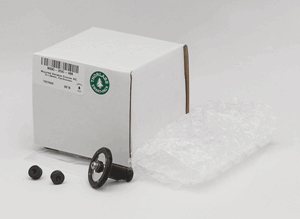
Click to Enlarge
Figure 6.2 NDC-25C-4M Packaging

Figure 6.1 Smart Pack Logo
Smart Pack
- Reduce Weight of Packaging
- Increase Usage of Recyclable Materials
- Improve Packing Integrity
- Decrease Shipping Costs
Thorlabs' Smart Pack Initiative is aimed at minimizing waste while providing adequate protection for our products. By eliminating any unnecessary packaging, implementing design changes, and utilizing eco-friendly materials, this initiative seeks to reduce the environmental impact of our product packaging.
The updated Mounted Round Variable ND Filters packaging primarily consists of recycled paper and cardboard and weighs 9.80 to 24.81% less than the original packaging, depending on the filter. This weight change results in a 0.69 to 2.14 kg reduction in travel-based CO2 emissions per year, based on typical product sales.
As we move through our product line, we will indicate re-engineered, eco-friendly packaging with our Smart Pack logo, which can be seen in Figure 6.1.
| Posted Comments: | |
Sam G
(posted 2025-04-30 18:41:00.943) is it possible to make it turn in a controlled/motorised way? cdolbashian
(posted 2025-05-01 10:56:19.0) Thank you for reaching out to ThorLabs with this inquiry! As of now we do not have a motorized version of the filter, though it is possible to mount our 25mm Round continuous filter into one of our standard motorized optic mounts. For example, you could mount NDC-25C-2-B into something like the PRM1Z8. I have contacted you directly to discuss this option as well as others. Morteza Darvishi
(posted 2025-04-03 17:46:22.763) We bought a mounted round continuously variable ND filter NDC-50C-4M. Is there any way to reduce the polarization rotation because of these variable ND filters?
When we reduce the optical power to the factor of 50, we have a polarization rotation such that the visibility in our Mach-Zehnder interferometer changes from 99.8% to 99.2%.
Thank you. cdolbashian
(posted 2025-05-01 11:35:06.0) Thank you for reaching out to us with this inquiry! This is troubling to hear. I have contacted you directly to troubleshoot this issue with the hopes of finding a alternative solution for you, based on your strict polarization requirements. user
(posted 2023-11-09 17:48:33.783) Hi, I noticed that all the Round Continuously Variable Metallic Neutral Density Filters are actually based on 2 mm thick BK7 or FS substrate. I am wondering if it is possible for you to customize the same things but on a thinner (1 mm) substrate. Please let me know. Thanks in advance! cdolbashian
(posted 2023-11-16 02:58:13.0) Thank you for reaching out to us with this custom request! This is something we can potentially do as a custom. I have contacted you directly to discuss the specifications of your request. Katsuya Iwata
(posted 2022-01-24 03:38:15.763) I would like to use this ND filter with a femtosecond pulsed laser (pulse width 35fs, center wavelength 808nm). How much the dispersion (GDD, TOD) of the transmitted pulses will be. cdolbashian
(posted 2022-02-10 12:08:46.0) Thank you for reaching out to us with this inquiry. I have contacted you directly with the results of my calculation for the GDD and TOD for a variable ND filter: 0.4 to 4.0 OD. In the future, please reach out to techsupport@thorlabs.com with these types of technical inquiries. GUILLAUME VIENNE
(posted 2021-11-17 11:26:52.067) Hello,
I am looking for the curve attenuation (dB) vs angle (deg) and cannot find it on your website.
Could you provide it to me?
Cheers! jgreschler
(posted 2021-11-18 10:27:44.0) Thank you for reaching out to Thorlabs. The relationship between OD which we specify for these filters and dB is a 1:10 relationship. For example if a filter is specified between 0.04 and 2.0 OD, that corresponds to 0.4 and 20db loss linearly increased over the 270 degree coating angle. Benjamin Portier
(posted 2021-06-07 08:59:23.967) Dear Sir/Madam,
I am using an uncoated ND filter wheel (NDC-100C-4M) with a laser source in the 850-950 nm range. We noticed that the laser power measured after the ND filter increased quite dramatically (+50-100%!) when temperature increases. We believe it comes from a combination of small wavelength shift of the laser source and a higher transmittance at higher wavelengths of the Inconel (NiCrFe) coating. Do you happen to have the spectral transmission data of that coating, so that we could investigate this shift more extensively?
Thanks in advance,
B.P. YLohia
(posted 2021-06-07 12:00:32.0) Hello B.P., thank you for contacting Thorlabs. These variable filters use the same inconel coatings as our fixed OD reflective filters. The spectral transmission data for those can be found on this webpage: https://www.thorlabs.com/newgrouppage9.cfm?objectgroup_id=6106. Mikhail Kochiev
(posted 2020-10-12 10:53:55.85) Hello. I used various 50 and 100-mm gradient filters and broke two of them. It seems this mounting with a fixed center is not safe. Any external force is applied to an edge, i.e. to a big lever with big torque. And glass filter easily breaks. Don't you suggest to mount these filters with RSP2/M mounts or like this? YLohia
(posted 2020-10-13 09:22:03.0) Hello, thank you for contacting Thorlabs. We are sorry to hear about the issues you have had with these filters. The glass is quite thin (2 mm) so, yes, careful handling is required. You can certainly use the RSP2/M to mount the 50 mm versions of these unmounted filters. We don't explicitly suggest this mounting scheme since it reduces the clear aperture of the filter, while the NDC-PM has a minimal impact on that. Duc Huy Nguyen
(posted 2020-10-12 02:21:25.747) Hi,
I'd like to know if I have broken Mounted Round NDC-50C-2M-A, how can I remove the outer rim and mount the new Unmounted filter with same diameter in to the rim? YLohia
(posted 2020-10-13 09:22:19.0) Hello, thank you for contacting Thorlabs. The NDC-50C-2-A filter is mounted into the housing using G14250 epoxy. We strongly recommend purchasing a new filter wheel instead of attempting to replace the existing wheel. I have reached out to you directly with more information. Kyle Wilkin
(posted 2019-12-12 20:03:33.74) Are there any motorized rotation mounts that would work with the continuous filter wheels? YLohia
(posted 2019-12-13 11:10:31.0) Hello, thank you for contacting Thorlabs. Unfortunately, we currently do not offer any motorized mounts for these continuous ND filters. That being said, I have posted your request in our internal engineering forum for further consideration as a future product. John Holzinger
(posted 2019-04-25 18:14:54.88) I am looking for an optical density round disc that I could pare with an LED and a photodiode and get an analog output. Also I would like the range to be over a minimum 350 degree range vs the 270 degree range that your standard rounds have. Is this a possibility? asundararaj
(posted 2019-04-26 02:41:38.0) Hello, thank you for contacting Thorlabs. Please click the red "Request Quote" button above to inquire about custom items. We will reach out to you directly to discuss the possibility of offering this. user
(posted 2019-04-18 17:38:10.063) Is there a straightforward way to mount these ND wheels onto the Thor labs optical chopper? YLohia
(posted 2019-04-19 10:39:16.0) Hello, thank you for contacting Thorlabs. Unfortunately, the ND filter wheels are not compatible with the optical chopper system at this time. Lmariedana
(posted 2019-02-26 15:47:37.5) i'm looking for information on cleaning this filter specifically. nbayconich
(posted 2019-02-27 11:13:31.0) Thank you for contacting Thorlabs. We recommend using compressed canned air to clean dust particles off the surface of these optics. The surface should never be touched as it can scratch the unprotected reflective coating. Caroline.amiot
(posted 2019-02-13 13:55:43.93) Hi,
Do you have any plan on proposing that kind of wheel for longer wavelengths (mid-IR)?
Thanks in advance for your answer. YLohia
(posted 2019-02-14 09:04:45.0) Hello, thank you for your interest in our products. Unfortunately, we currently do not have any plans for releasing this product for the mid-IR. That being said, I will post your suggestion on our internal engineering forum for further consideration. user
(posted 2017-09-20 13:11:33.337) Hi,
Your explanations regarding neutral density filter damage threshold are horrible. I have a PhD in optical physics and could not determine whether your filters are suitable for my cw laser or not. Ultimately, I could not find LIDT values for your filters for a cw laser. tfrisch
(posted 2017-10-04 12:49:41.0) Hello, thank you for contacting Thorlabs. Unfortunately, we do not yet have both pulsed and CW damage threshold data for all of our optics, and I'd expect the damage mechanisms to differ, so converting from pulse to CW may not be possible. I'd be glad to discuss the damage thresholds of similar optics if you reach out to me at TechSupport@Thorlabs.com. Generally, filters on the below page will have a similar Inconel coating, so that would be a good guideline to use for damage threshold.
https://www.thorlabs.com/newgrouppage9.cfm?objectgroup_id=5022 tanmaybhwmk3
(posted 2017-07-28 18:26:52.713) What is the maximum power it can tolerate?
In damage threshold part, I couldn't find out for upto what maximum CW power, it is recommended by thorlabs.
We have two 1.7 Watt 532 nm Green laser. Please give your valuable reply regarding this. tfrisch
(posted 2017-07-28 11:59:26.0) Hello, thank you for contacting Thorlabs. The damage threshold in the CW regime will be similar to the damage threshold of our other inconel coated filters. However, since this is continuously rotational, it is typically used with a small beam size to avoid a significant change in power across the beam's cross section. Damage would depend on beam size, but I would expect a 1mm beam diameter with 1.7W would probably be too high in linear power density, for example. I will reach out to you to discuss this application directly. A pair of polarizers or a waveplate/polarizer pair may provide a more suitable variable attenuation. user
(posted 2017-05-25 17:24:32.267) In the damage threshold tab, it is not clear what the CW damage thresholds are - i.e. in units of W/cm or W/cm^2 (although the pulsed values are given). Please could these be given?
Specifically, I have a 200W laser beam at 975 nm with 18 mm flat-top shape - will this cause damage for any rotation of the NDC-100C-4M product please? nbayconich
(posted 2017-06-08 05:31:18.0) Thank you for contacting Thorlabs. At 200W with your beam diameter this will most likely damage the NDC series filters. They use the same "Inconel" reflective coating as our reflective ND filters and will have a similar CW limit. I will reach out to you directly regarding recommended CW damage thresholds of these ND filters. chenav
(posted 2016-12-18 17:59:03.62) We *really* should have a way to lock the rotation of the variable ND filters. In some applications, inadvertently rotating such a filter could cause serious damage to equipment down the optical path, making these filters an unacceptable solution in such cases. tfrisch
(posted 2016-12-19 11:04:52.0) Hello,thank you for contacting Thorlabs. For applications where minor adjustments can saturate or damage equipment, but a continuously variable attenuation is still required, I would recommend a screw actuated solution such as NEV0830M or NDL-10C-2 mounted in XYFM1. I will reach out to you with more details on these potential solutions. simon.englisch
(posted 2016-03-03 10:28:16.53) What is the difference in substrate of this variable filter to the normal reflective ND filters in UV fused silica like NDUV01B?
The latter are specified for down to 200 nm, while the variable round one only goes to 240 nm and the text mentiones something like absorption.
I am using your reflective ND filter set with a ~213 nm laser and was thinking about replacing the filter wheels with NDUVxxB filters with this variable wheel to have a more precise OD tuning. Will NDC-100C-2 work at 213 nm? How much absorption has the undamped area? besembeson
(posted 2016-03-09 06:20:36.0) Response from Bweh at Thorlabs USA: The uncoated section should have similar transmission. The coatings however are different which will lead to differences in spectral response. You should be okay with the variable filter for your 213nm wavelength. If not satisfied, we can do a special variable ND filter that will give you similar response. tywang
(posted 2015-09-23 14:48:15.54) I bought a NDC-50C-2M-A - Mounted Continuously Variable ND Filter several month ago. Recently, I noticed the laser power passing through the filter is much smaller that it should be. For example, when the angle of this filter is 95, 100, 105, 110, 115, 120, 125 and 130, their corresponding theoretical value of the laser power transmit the filter should be 84.31%, 71.08%, 59.08%, 50.54%, 42.61%, 35.92%, 30.29% and 25.54%. I calculate these theoretical value basing on the information from your website. However, according to my measurement of transmitted laser power by powermeter, the transmitted laser power at these angles are 44.5%, 40.6%, 33.9%, 28.3%, 24.8%, 22.1%, 18.3% and 16.8%. The measure value is much smaller than the theoretical value. The output laser power is 60 mW. besembeson
(posted 2015-10-07 12:50:31.0) Response from Bweh at Thorlabs USA: The optical density is a linear function of angle, with the linear constant being 0.00741 [due to the 0-2 OD range] for the NDC-50C-2M-A. At 95 deg on the graduated wheel for example, the OD will be 0.00741*5 or 0.04 giving a transmission of about 91.82%, which is not 84.31%. I will contact you to further discuss your calculations and measurements. cottsb
(posted 2015-06-16 17:56:03.653) I think that I received my NDC-50C-2M with the mount part where the you screw in the postholder on backwards. What is the proper procedure to dissemble the mount and flip that part around and reassemble it? The mounting hole is too close to the wheel itself to fit in a post so I want to flip the large semicircular mounting bracket. besembeson
(posted 2015-09-21 11:36:50.0) Response from Bweh at Thorlabs USA: I will contact you directly regarding replacing this for you. user
(posted 2014-12-01 14:27:50.8) We need to know OD at where just coating starts. We do not see the OD info... Will contct your local office soon. jlow
(posted 2014-12-11 11:41:52.0) Response from Jeremy at Thorlabs: About 1/4 of the round ND filter is uncoated. The OD is a linear function of the angle. The formula for calculating the OD is located in the "Specs" tab on this page. tcohen
(posted 2012-12-06 16:23:00.0) Response from Tim at Thorlabs to Ian: Thank you for contacting us. It is possible that you are seeing the temperature dependence of the filter. As your source heats the optic it is increasing the OD until an equilibrium is reached. We will gather some data on this and I will contact you to keep you updated. tcohen
(posted 2012-12-06 16:14:13.087) Response from Tim at Thorlabs to Chek: Thank you for your feedback. Data on the 2.0 Inconel coating that we generated on N-BK7 has showed a flat OD out to your wavelength. I will contact you with this data. ian.block
(posted 2012-11-24 07:28:11.45) We have noticed that this component has an initial time-dependent response. With a 300mW ~1mm diam. 660nm incident beam, the transmission drops in an exponential (vs time) fashion by nearly 50% over ~60s after which it stabilizes. With a 20mW ~1mm diam. 633 incident beam, the behavior is significantly less pronounced but nonetheless observed. The behavior is repeatable (and thus there seems to be no damage to the material) but this is extremely inconvenient for certain applications. Is this normal? chek.cheung
(posted 2012-11-13 22:35:57.567) What is the optical density range in the wavelength from 1500nm-2200nm, if i choose the OD=2.0 in stock? jlow
(posted 2012-10-04 09:40:00.0) Response from Jeremy at Thorlabs: The NDC filters are reflective ND filters. For OD of 1.0, the damage threshold is 1000 W/cm2 (532 nm, CW, Ø0.019 mm beam spot), and 0.025 J/cm2 (532 nm, 10 ns, 10 Hz, Ø0.566 mm beam spot). rpeterson2205
(posted 2012-10-03 15:17:37.0) I need to know damage thresholds when comparing ND products. bdada
(posted 2011-09-12 16:19:00.0) Response from Buki at Thorlabs:
These continuous neutral density filters do not have a high damage threshold. A reflective neutral density filter was tested and was damaged at the following power: 0.05J/cm^2, at 532nm, 10ns pulses, and 10Hz rep rate. These are most suited for low power applications. Please contact TechSupport@thorlabs.com if you have additional questions. kchow
(posted 2011-09-09 13:49:20.0) I would like to get some infomation on damage threshold for these filters please.
kam cgruenewald
(posted 2011-09-05 18:18:39.0) What is the maximum power which can be irradiated onto these filters? I have a 300mW 532nm laserspot with 1 mm diameter (cw). Will it destroy the filter? jjurado
(posted 2011-08-16 09:54:00.0) Response from Javier at Thorlabs to onjoya: Thank you very much for contacting us. We will send you information regarding the transmission of these continuously variable ND filters with respect to angle shortly. onjoya
(posted 2011-08-12 16:29:29.0) Im new to our lab and cant find the manual for our ND filter. Can anyone tell me how to convert the angle (number on the scale) to transmitted intensity? jjurado
(posted 2011-06-23 19:09:00.0) Response from Javier at Thorlabs to kristinwustholz: Thank you very much for your feedback. The beam shape is most likely being affected by dirt in the optic. The cleaning procedure for this ND filter is very similar to that of a regular lens. There are a few methods that you can use to clean the optic, such as washing it with distilled water and optical quality soap, using the drop and drag method using a fast drying solvent, or cleaning with an applicator. For more info, you can follow our optics cleaning tutorial:
http://www.thorlabs.com/tutorials.cfm?tabID=26066
I will contact you directly for further assistance. kristinwustholz
(posted 2011-06-21 10:17:21.0) Weve found that rotating the ND filter produces changes in the beam shape of our laser at the sample. Therefore, we cannot adjust the ND filter once an experiment has started. Otherwise, the beam shape and alignment is perturbed. Any suggestions? There also appears to be some smudges on the surface of the optic.. what is the recommended cleaning procedure for the NDC-50C-4? Customer Email: kristinwustholz@gmail.com This customer would like to be contacted. apalmentieri
(posted 2009-10-28 16:33:35.0) A response from Adam at Thorlabs: Paul, the 1200nm maximum range is due to the coating not the fused silica. They can be used outside of the 1200nm range, but we cannot provide any guarantee on the specifications. If you would like, we can offer these with the back side AR coated. I will email you to get more information. paul
(posted 2009-10-28 15:14:36.0) The spec show wavelength range of 380 - 1200 nm. Is 1200 nm the max wavelength due to coating or fused silica? We need out to 1320 nm. Can these be made of another glass than fused silica as it has an absorption dip there. Can these be made of BK7. Can the back side be AR coated to reduce transmission variations due to interference when used with a laser. klee
(posted 2009-06-23 11:30:47.0) A response from Ken at Thorlabs to carddb: The PRM1Z8 (replacment for PRM1-Z7) can hold Ø1" optics so you can simply drop in a unmounted Ø25 mm NDC filter and lock it in place with a retaining ring (included with PRM1Z8). Our optics department is also investigating the possibility of having a motorized version of these filters. I will forward your suggestion to them. carddb
(posted 2009-06-23 10:43:49.0) At diffent times there has been a need for a motorized rotational stage for the round variable filter. It might be as simple as providing an adaptor to the PRM1-Z7 stage.
Let me know if this is possible.
Thanks
Darrell Card Laurie
(posted 2008-11-12 17:12:21.0) Response from Laurie at Thorlabs to dale.otten: Thank you for your feedback. In this particular case, these items were purposely designed so that the coating only covers 3/4 of a circle (the design can be seen fairly well on the pictoral view shown under the specs tab). The reason is that some applications may benefit from being able to position the filter such that the beam doesnt experience any attenuation (other than what will naturally occur due to the ~4% surface reflections. dale.otten
(posted 2008-11-12 16:59:05.0) http://www.thorlabs.com/NewGroupPage9.cfm?ObjectGroup_ID=1393
I am wondering what this means in the overview by the Ind. coating is "coated through a full 270`". Why not a full 360`? Is this a typo, or are these ND filters only coated 3/4 of the way around? acable
(posted 2007-12-22 12:32:53.0) The price box descriptions need rewriting so the differences in each model show instead of all the characturistics that are the same. Perhaps just replacing Optical Density with OD would be enough. |

These circular, continuously variable neutral density filters provide adjustable attenuation via rotation. The optical density (OD, see Equation 1 in the Overview tab) increases linearly from the start of the coating. The filters are coated through a full 270° arc.
If you wish to mount one of these filters onto a TR series post, that can be accomplished using the NDC-PM Post Mount Assembly shown below.

These mounted versions of our variable neutral density filters come with angular graduations and are mounted on an NDC-PM rotating axle mount. The mount has been carefully designed to minimize the effect on the clear aperture of the optic. Adapters for both 8-32 and M4 mounting holes are included with each filter, enabling compatibility with Thorlabs' Ø1/2" TR Series Posts.

- Back Side is Antireflection-Coated for 350 - 700 nm
- Two Optical Density Ranges: 0.04 - 2.0 or 0.04 - 4.0
These unmounted ND filters feature the same 270° metallic ND coating on the front surface as the filters above but also have an antireflection coating deposited on the back side. The -A AR coating, designed for the 350 - 700 nm wavelength range, minimizes secondary reflections, making these filters an ideal choice for use in optical systems where back reflections are a concern.
If you wish to mount one of these filters onto a TR series post, that can be accomplished using the NDC-PM Post Mount Assembly shown below.

These mounted, AR-coated, variable neutral density filters come with angular graduations and are mounted on an NDC-PM rotating axle mount. The mount has been carefully designed to minimize the effect on the clear aperture of the optic. Adapters for both 8-32 and M4 mounting holes are included with each filter, enabling compatibility with Thorlabs' Ø1/2" TR Series Posts.
These ND filters feature the same 270° metallic ND coating on the front surface as the filters above but also have an antireflection coating deposited on the back side. The -A AR coating, designed for the 350 - 700 nm range, minimizes secondary reflections, making these filters an ideal choice for use in optical systems where back reflections are a concern.

- Back Side is Antireflection-Coated for 650 - 1050 nm
- Two Optical Density Ranges: 0.04 - 2.0 or 0.04 - 4.0
These unmounted ND filters feature the same 270° metallic ND coating on the front surface as the filters above but also have an antireflection coating deposited on the back side. The -B AR coating, designed for the 650 - 1050 nm wavelength range, minimizes secondary reflections, making these filters an ideal choice for use in optical systems where back reflections are a concern.
If you wish to mount one of these filters onto a TR series post, that can be accomplished using the NDC-PM Post Mount Assembly shown below.

These mounted, AR-coated, variable neutral density filters come with angular graduations and are mounted on an NDC-PM rotating axle mount. The mount has been carefully designed to minimize the effect on the clear aperture of the optic. Adapters for both 8-32 and M4 mounting holes are included with each filter, enabling compatibility with Thorlabs' Ø1/2" TR Series Posts.
These ND filters feature the same 270° metallic ND coating on the front surface as the filters above but also have an antireflection coating deposited on the back side. The -B AR coating, designed for the 650 - 1050 nm range, minimizes secondary reflections, making these filters an ideal choice for use in optical systems where back reflections are a concern.

Video G7.2 NDC-PM Post Mount Assembly Usage

Click to Enlarge
Figure G7.1 Continuous Filter Mounted on Post Using NDC-PM Assembly
The NDC-PM Post Mount Assembly allows you to mount any of our round, unmounted, continuously variable (or step) ND filters onto a rotating axle that can be threaded onto any Thorlabs Ø1/2" Post. The mount has a minimal effect on the clear aperture of the ND filter. Adapters for both 8-32 and M4 mounting holes are included with each mount.
To mount a filter, first tighten the setscrew on the side of the NDC-PM assembly using the included hex key to lock rotation. Using either a 5/64" or 2 mm hex driver, remove the silver screw, insert the filter between the two washers, and replace the wheel and screw assembly. Take care to replace the flat metal washer and spring washer in the original order (see Video G7.2), and tighten the bolt. The hex bolt threads into a 0.75" long Ø6 mm rod, the rotation of which may be locked using the included 0.050" hex key. If a longer distance is needed between the post and the filter wheel, the included 0.75" long rod can be swapped for a standard ER rod.
 Products Home
Products Home











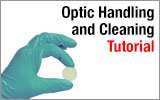
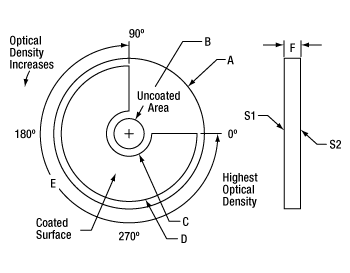

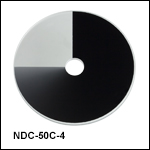
 Zoom
Zoom

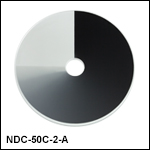

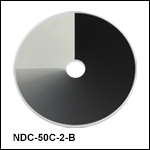


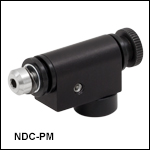
 Variable ND FiltersContinuous ND, Reflective
Variable ND FiltersContinuous ND, Reflective